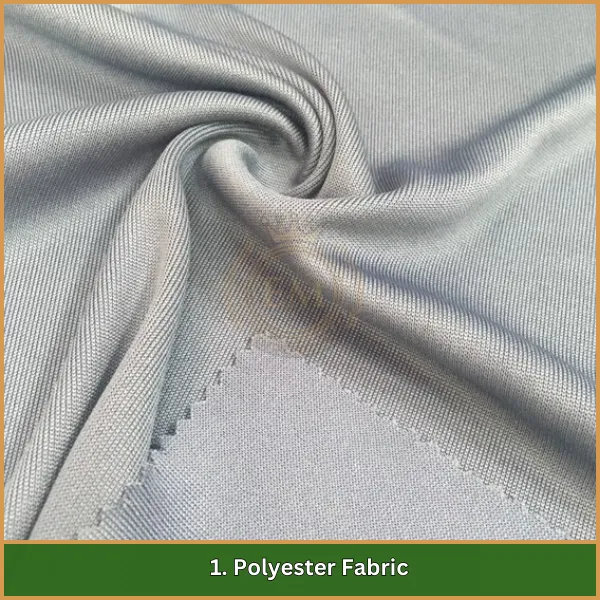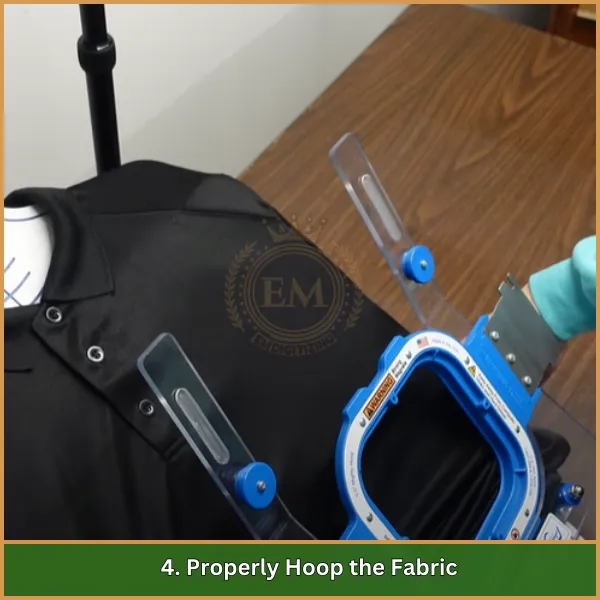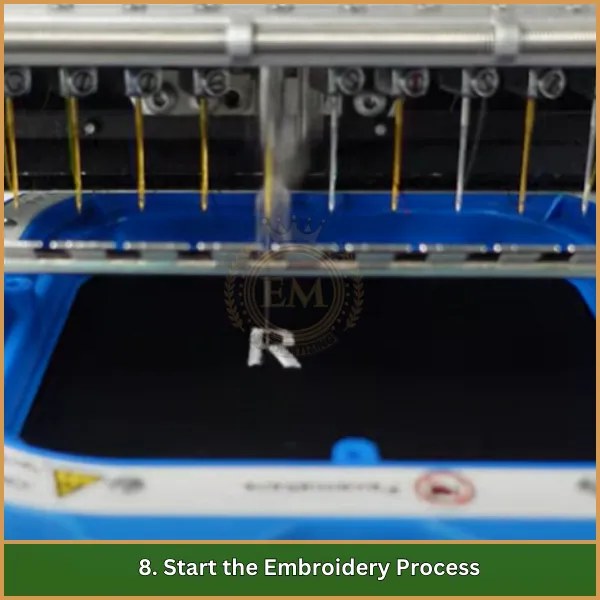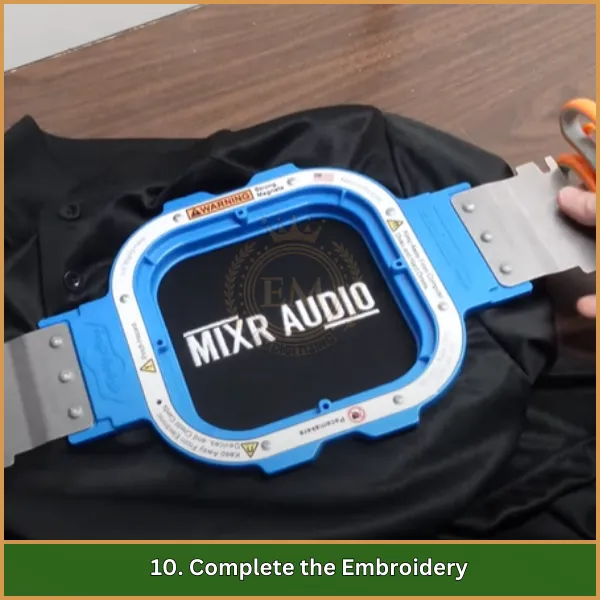¿Alguna vez has tenido problemas con el bordado sobre tela de poliéster?? No es ningún secreto que el poliéster puede ser complicado: es resbaladizo, elástico, y necesita un poco de cuidado extra. Pero no dejes que eso te detenga! Con las herramientas y métodos adecuados, puedes lograr resultados sorprendentes.
El poliéster es un tejido imprescindible para la ropa deportiva., uniformes, y accesorios elegantes. Su durabilidad es inigualable, pero cuando se trata de bordado, necesitarás usar el estabilizador correcto, aguja, e hilo para evitar problemas como arrugas o costuras desiguales.
En esta guía, Le mostraremos consejos y técnicas sencillas para manipular poliéster con confianza.. Si eres principiante o experimentado, Estos pasos te ayudarán a crear diseños que lucirán profesionales y durarán mucho tiempo.. Listo para empezar? Vamos a sumergirnos!

Bordado sobre tejido de poliéster | Guía paso por paso
Materiales esenciales para un bordado perfecto en poliéster
Bordar sobre tela de poliéster puede ser una experiencia gratificante si cuentas con los materiales adecuados. Cada herramienta y accesorio juega un papel clave para garantizar que sus diseños sean nítidos., profesional, y duradero. Aquí encontrará todo lo que necesita para un bordado de poliéster exitoso.
- Tejido de poliéster
- Hilo de bordar de poliéster
- Maquina de bordar
- Aros de bordado (preferiblemente plástico)
- Estabilizador (arrancable o recortado)
- Marcador de tela o tiza
- Tijeras o tijeras
- Estabilizador de cobertura (Opcional, para ciertos diseños)
1. Tejido de poliéster

El poliéster es un versátil., tela duradera, perfecto para bordar. Su superficie lisa y su resistencia al desgaste lo hacen ideal para diseños tanto complejos como simples.. Sin embargo, tiene algunos desafíos: se estira fácilmente y es sensible al calor. El uso de estabilizadores y configuraciones de baja temperatura puede ayudar a evitar estos problemas..
2. Hilo de bordar de poliéster
El hilo para bordar telas de poliéster cambia las reglas del juego. Ofrece colores vibrantes., excelente durabilidad, y resistencia a la decoloración, incluso después de lavados frecuentes. Este hilo coincide con la resistencia y flexibilidad del tejido., asegurando que su bordado permanezca intacto.
3. Maquina de bordar
Una máquina de bordar eficiente es tu mejor aliada para trabajar el poliéster. Elija una máquina con controles de tensión precisos y diseños programables para manejar la textura resbaladiza del poliéster y ofrecer resultados consistentes..
4. Aros de bordado (Preferiblemente plástico)
Los aros de plástico sujetan mejor la tela de poliéster que los de madera.. Previenen el deslizamiento y ayudan a mantener la tela tensa., asegurando que su bordado quede suave y cosido uniformemente.
5. Estabilizador (Desgarrable o recortable)
Los estabilizadores son esenciales para controlar el estiramiento del poliéster.. Un estabilizador desprendible es ideal para bordados ligeros., mientras que un estabilizador recortado brinda soporte adicional para diseños densos o detallados.
6. Marcador de tela o tiza
La colocación precisa es clave para un bordado impecable. Los marcadores para tela o tizas te ayudan a marcar el área de diseño sin dejar manchas permanentes., asegurando que su bordado esté perfectamente alineado.
7. Tijeras o tijeras
Los bordes limpios importan! Las tijeras o tijeras de alta calidad le permiten recortar cuidadosamente el exceso de hilo y el estabilizador., dándole a tu proyecto un acabado profesional.
8. Estabilizador de cobertura (Opcional)
Para tejidos de poliéster texturizados o elásticos., un estabilizador de cobertura es una gran adición. Evita que las puntadas se hundan en la tela., lo cual es especialmente útil para diseños atrevidos o detallados..
Proceso de bordado a máquina sobre tejido de poliéster
Bordado de tela de poliéster puede producir resultados sorprendentes si se aborda con las herramientas y técnicas adecuadas. Aquí le mostramos cómo comenzar y garantizar el éxito.
1. Prepara la tela

Lave la tela de poliéster con un detergente suave y agua fría para eliminar la suciedad o los residuos que puedan interferir con el bordado.. Planche ligeramente a temperatura baja para suavizar las arrugas., asegurando una limpieza, superficie plana para coser. Evite el calor alto para evitar daños a la tela..
2. Seleccione y digitalice su diseño

Elija un diseño que coincida con su proyecto y digitalícelo usando un software de bordado. Ajuste la densidad y los tipos de puntadas según la naturaleza resbaladiza del poliéster.. Si la digitalización parece un desafío, EMdigitalización ofrece servicios profesionales para convertir su obra de arte en archivos de bordado de alta calidad, asegurando resultados perfectos en todo momento.
3. Elija los colores de hilo perfectos

Elige poliéster hilos de bordar que complementan o contrastan con tu tela. Estos hilos son duraderos., vibrante, y diseñado para soportar lavados frecuentes. Utilice códigos de hilo adecuados para lograr una combinación de colores precisa.
4. Colocar correctamente la tela en el bastidor

Colocar un estabilizador (arrancable o recortado) en el aro inferior. Coloca la tela de poliéster encima., asegurando que sea suave y sin arrugas. Asegure la tela colocando el aro superior., manteniéndolo tenso pero no demasiado estirado para evitar arrugas.
5. Marque la ubicación del diseño

Utilice un marcador para tela soluble en agua o tiza de sastre para marcar el centro y los puntos de alineación de su diseño.. Esto ayuda a posicionar el bordado con precisión..
6. Prepare su máquina de bordar

el cliente esta muy contento, procedimientos de seguimiento mejorados. Como desarrollador de suelo, penas, ni el ullamcorper de la propiedad, una almohada de proteínas.
7. Ajustar la configuración de la máquina

Ajuste la velocidad de la máquina a un nivel moderado., entre 500 y 800 puntadas por minuto, para manipular telas de poliéster de manera efectiva. Ajuste la longitud de la puntada según la complejidad del diseño., con puntadas más cortas para áreas más densas y más largas para textura.
8. Iniciar el proceso de bordado

Comience a coser mientras monitorea de cerca el progreso.. Esté atento a posibles roturas de hilo o arrugas en la tela.. Detenga la máquina si es necesario para realizar ajustes de tensión o alineación..
9. Supervisar el progreso y realizar ajustes

Pausa la máquina de vez en cuando para inspeccionar el bordado.. Asegúrese de que los puntos sean consistentes., y ajuste el aro o la configuración de tensión si es necesario para mantener la precisión.
10. Completa el bordado

Una vez terminado el bordado, Retire con cuidado el aro de la máquina.. Recorte los hilos sueltos y retire el estabilizador sin tirar de la tela.. Si usaste un estabilizador de cobertura, retírelo suavemente del diseño.
11. Cuidar la pieza terminada

Lave la tela bordada suavemente para eliminar las líneas de tiza o marcador.. Si es necesario, Planche ligeramente a temperatura baja para suavizar las arrugas y darle un aspecto pulido..
Consejos para bordar con éxito en poliéster
Lograr un bordado impecable en tela de poliéster requiere precisión, las herramientas adecuadas, y técnicas reflexivas. A continuación se ofrecen algunos consejos prácticos que le ayudarán a crear diseños impresionantes..
- Opte por agujas de bolígrafo: Las agujas de punta redondeada, como las de bolígrafo o las agujas elásticas, se deslizan entre las fibras., reduciendo las puntadas saltadas y previniendo daños a la tela.
- Elija hilos coincidentes: Utilice hilos de bordar de poliéster o rayón por su flexibilidad y brillo.. Estos hilos complementan mejor el tejido de poliéster que el algodón., que carece de elasticidad.
- Modifique la configuración de su máquina: Ajuste su máquina de bordar para reducir la densidad de puntadas y apretar ligeramente la tensión.. Manteniendo la velocidad moderada (alrededor 500-800 puntadas por minuto) minimiza los cambios durante la costura.
- Digitalizar inteligentemente: Planifica tu diseño teniendo en cuenta el poliéster. Digitalice patrones para coser hacia afuera desde el centro para minimizar el estiramiento y la distorsión..
- Utilice adhesivo para mayor estabilidad: Un ligero rocío de adhesivo temporal sobre el estabilizador ayuda a asegurar la tela y mantenerla en su lugar durante la costura..
- Mantenga los diseños simples: Evite diseños demasiado densos, ya que pueden provocar arrugas. Opte por contornos limpios y rellenos menos complejos para obtener mejores resultados.
- Pruebe antes de coser: Pruebe siempre sus ajustes en un trozo de tela de poliéster para evitar errores costosos en su pieza final..
Conclusión
Hacer bordado sobre tela de poliéster puede ser sencillo si utilizas las herramientas adecuadas y sigues los pasos correctos.. Con buenos estabilizadores, agujas, y técnicas adecuadas, puedes hacer que tus diseños luzcan increíbles. El poliéster puede resultar complicado al principio, pero con el enfoque correcto, se vuelve mucho más fácil.
Si quieres diseños perfectos y sin complicaciones, prueba EMDigitalización! Ofrecemos asequible servicios de digitalización con tiempos de respuesta súper rápidos y calidad garantizada. Más, podrás ver una vista previa gratuita de tu diseño antes de finalizarlo.
¿Eres un nuevo cliente?? Obtendrás una exclusiva 50% descuento en tu primer pedido! No pierdas esta oportunidad de hacer tus proyectos de bordado más fáciles y mejores con EMDigitalización.
Haga clic aquí para comenzar!
preguntas frecuentes
Absolutamente! La tela de poliéster es excelente para bordar cuando se maneja correctamente. Con el estabilizador adecuado, aguja, y hilo, puedes lograr diseños hermosos y duraderos en este tejido versátil.
Los diseños livianos con menor densidad de puntada son ideales para poliéster. Este tipo de diseños reducen el riesgo de arrugas y garantizan que la tela mantenga su forma durante todo el proceso..
Sí, Es imprescindible utilizar agujas de bolígrafo e hilos de poliéster.. Las agujas de bolígrafo se deslizan suavemente a través de las fibras., y los hilos de poliéster garantizan resistencia y flexibilidad para su bordado..
Sí, el poliéster se puede estirar, que podría distorsionar su diseño. Para prevenir esto, Evite apretar demasiado la tela en el aro y use un estabilizador para mantener todo en su lugar..
